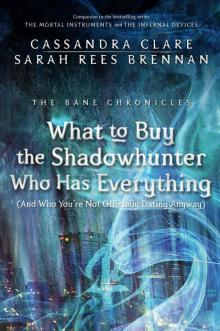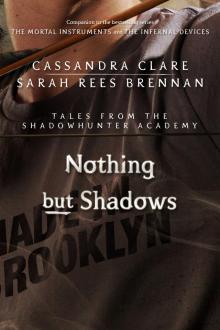- Home
- Cassandra Clare
Shadowhunter’s Codex Page 10
Shadowhunter’s Codex Read online
Page 10
* * *
CHANGELINGS
The most common contact that the fey have with mundanes is in the making of changelings. It is not dissimilar from the manner whereby the Nephilim create new Shadowhunters with the Mortal Cup, but in the case of the fey, the mundanes gain no benefit. The faeries sneak into a mundane home, take a suitable child, and replace it with a sickly member of their own race. The human child thus grows up in Faerie, able to bring fresh strong blood into the faerie lines, while the mundanes find themselves forced to parent a dying child terrified of iron. It’s generally believed that the faeries exchange one of their own partly to allay the suspicions of mundanes and partly out of a twisted, and very fey, sense of fair exchange.
By some method unknown to us, mundane children raised in Faerie take on fey attributes, and can perform some faerie magic. By the same token the fey child left in the mundane world, if he survives, typically never knows his own origin. Apart from a predilection for the Sight, he may never come to know anything of the magical world at all.
By Covenant Law we are forbidden from interfering with this process of child exchange. This ruling has been debated hotly at several of the Accords proceedings over the past hundred years, but both of the children are raised in loving homes—the fey choose the unwitting adoptive parents of their offspring carefully—and no better solution for refreshing the faerie bloodlines has been found. Pragmatism leads Nephilim to prefer that the fey create changelings rather than abduct adult mundanes into their revels.
THE LAND OF FAERIE
The realm of Faerie is not one that is welcoming to Shadowhunters, and in general Nephilim should avoid spending time there. Despite our powers and our Sight, we are still as susceptible to the lures and dangers of Faerie as most mundanes. The fey have always been clear that their signing of the Accords represents their covenant for behavior in our realm, not in theirs. Faerie is older than the Accords, older than the Nephilim, and it possesses its own magic that the Gray Book can only partly and imperfectly protect against, at best.
That said, Faerie does have rules, and those rules do not leave Nephilim helpless. A Shadowhunter who is the victim of an unprovoked independent attack by a creature of Faerie is allowed by fey law to defend herself. If the attacking creature is killed, the fey are likely to shrug and explain that the creature’s decision to attack was his own, and if that decision turned out poorly, it was not the problem of other fey. (One must, of course, be careful that such an attack is not on the orders of some other creature or court; it is always worth remembering that the only thing that the fey like more than meddling in human affairs is their own internal political fights. A Shadowhunter who became a piece in one of the faeries’ elaborate games of human chess would be very unlucky indeed.)
Entrances to Faerie tend to be hidden, rather than guarded, and tend to be permanently located in a single place. (The fey may close an entrance and open a new one when the original entrance has become dangerous or unworkable, or in the rare case when wars break out between fey courts and entrances must be closed or guarded.) Faerie entrances are normally found in natural surroundings rather than in man-made areas, and they are often given away by some aspect of their natural appearance that is “wrong” or “off”—a tree in an impossibly specific shape, a reflection in water that does not match the world above the reflection, an apparently empty cave from which faint music can be heard if all else is quiet.
For the most part it is wise for Shadowhunters to avoid Faerie. Though it is described as a realm and one can travel in it like in a country, it does not tolerate being surveyed and does not have a consistent layout. Seasons can change in the blink of an eye, mountains and caverns can appear where minutes before no such things were visible, and its rivers change their courses at the whim of some unknown force. No map of Faerie has ever been produced. Do not wander there; you are likely to join the untold throng of humans who have crossed the borders into the feylands and never returned.
What a surprise, that we are all mixed up with faerie stuff that we should absolutely positively avoid. Have we as a group ever met a warning we didn’t ignore?
Speak for yourself, Fangs.
DISCUSSION QUESTIONS AND THINGS TO TRY
1. What is your favorite Downworlder? Why?
Warlocks, because they are fabulous!
Offended. Also, many warlocks not fabulous. Only the one we know.
Vampires, because they keep bothering me. This question is stupid.
2. Do you have any prejudices about any Downworlders that might affect your ability to work with them? If so, it is important to recognize these biases and discuss them with the head of your Institute before you begin active service.
Vampires keep bothering me, a werewolf gives me my curfew, a warlock hid my memories from me, and faeries are just constantly messing with me.
The part where you’ve learned that Downworlders are a pain in the neck is accurate.
Honestly, the stuff Downworlders have done is nothing compared to what Shadowhunters have done to me, so . . .
3. Have you been tested to see if you possess inherited faerie or werewolf blood? It may affect your ability to take on certain Marks. Symptoms to look for include naturally occurring Sight and frequent cravings for red meat, respectively.
Um, no, actually. I haven’t.
I think you’re pretty safe. Both of your parents were full Shadowhunters, and one of them was obsessed with blood purity.
I bet Valentine had a werewolf grandmother or something. That’s usually how that kind of thing turns out.
I just wrote a thing, but it was not appropriate for a textbook so I erased it.
A room. You two. Get one.
ANGELS:
OUR MYSTERIOUS PATRONS
also terrifying
No “If You Meet an Angel” section, Codex? You are not helpful to me at all.
About angels little is known, much is conjectured, and few who might speak knowledgeably live to do so. Of all the supernatural creatures discussed herein, we know the least about angels. They are the great absent generals of our army, having left us a thousand years ago with their heavenly endorsement, basic marching orders, and enough magic to fight for ourselves. Much has been done in their name, both good and evil, even though the number of confirmed manifestations of angels in our world in the entire history of the Nephilim can be counted on one hand.
And yet their blood runs in the veins of every Nephilim, your-self included, flowing into our bodies through the transformative properties of the Mortal Cup. Angels may be absent patrons, but our patrons and spiritual parents they are, and we recognize them with our prayers, our invocations, and in the names of our most holy weapons.
In truth no one knows why angels are so distant from the events of our world. The first great heretical question of Nephilim history is one that has probably already occurred to you: If Raziel and his angels were so determined to wipe the demonic menace from our world, why not do it themselves? Like so many other questions about the nature and purpose of angels, this one remains unanswerable, and angels remain an ineffable foundation upon which our lives and our mission are built.
Writings about angel sightings through history are notoriously unreliable. The general consensus is that angels are shaped like humans, but are much larger, winged, and glowing with heavenly fire—but many authors have suggested that when angels do manifest in our world, they take whatever shape witnesses will recognize as angelic. Today the Clave is dubious of claims about angel appearances and mostly declines to investigate them. This attitude has been firmly in place ever since an embarrassing episode in 1832 during which a Prussian farmer and Shadowhunter, Johannes von Mainz, called the entire Clave to his farm to witness the “angel” he had summoned to his cow barn. Awe quickly turned to chagrin when some of the neighbors recognized the “angel” as Johannes’s son Hans, covered in gold leaf and bellowing pronouncements in a vulgar mix of Latin, German, and what appears to have been a nonsense
language of Hans’s own invention. The angel’s wings turned out to be a mix of goose, duck, and chicken feathers haphazardly pasted to a wooden frame. Johannes retreated to his farm in humiliation, and Hans was no longer able to so much as go into town without receiving catcalls and being pelted with feathers. Since then most Shadowhunters have been very cautious in either making or checking claims of angel appearances. Oh, Johannes, what will we do with you?
THE ANGEL RAZIEL
Teacher? I did an independent study, does that count?
Yes. You may skip this section. Enjoy your newfound sixty seconds.
The Angel Raziel holds, of course, a special role as the patron of the Shadowhunters and the creator of the Nephilim. His role in that creation is discussed thoroughly elsewhere in this volume; here we address what is known about Raziel himself.
Raziel is believed to be of the rank of archangel, within the heavenly chorus. In Jewish mystical traditions he is often called the Keeper of Secrets and the Angel of Mysteries. Interestingly, Jewish mysticism includes what appears to be a distorted version of the Gray Book, known as the Book of Raziel and containing a strange amalgam of kabbalistic teachings, angelology, glosses on the Jewish creation stories, and corrupted forms of demonic incantation. The book also contains a large number of runes, most of them totally invented but some of them corruptions of true Marks (but without any instruction on how they might be used or what their purpose might be). Extant copies of this text exist in both Hebrew and Latin today but only as historical curiosities. The movement during the mundane Renaissance in Europe against magic of all kinds labeled the book a dangerous work of dark magic, and its use was suppressed by mundane religious authorities, to the benefit of the Nephilim.
It is difficult to make any clear statements on Raziel’s earthly appearance; we can go only from the earliest art and text describing and depicting the birth of the Nephilim. From that, we can put together, as it were, a composite sketch. We can say that the Angel is consistently depicted as many times the size of a man, as having long hair of silver and gold, as being covered in golden Marks not found in the Gray Book, and as a being whose appearances “fled from the mind and memory as quickly as they were seen.” Many depictions show him with large golden wings, each feather of which contains a single golden eye.
Unfortunately, when speaking of the first meeting of the Angel Raziel and Jonathan Shadowhunter, an act of great symbolic as well as actual significance, it is difficult to divide what is intended as factual description from what is meant as allegory. Since history has not preserved a record of this first meeting—as told by Jonathan himself or even by anyone who personally knew Jonathan—all depictions of Raziel must be assumed to have some kernel of truth but also some kernel of interpretive fiction.
What is generally accepted is that Raziel is (a) huge, (b) terrifying, and (c) displeased to be dragged into human affairs, preferring for us to use the tools granted us to solve our own problems. There are many (possibly apocryphal) stories through Nephilim history of unfortunate Shadowhunters attempting to summon Raziel, only to be quickly smote and reduced to ash for wasting the Great Angel’s time. The Mortal Instruments are meant to summon Raziel and provide protection so that the summoner will not, in fact, suffer a swift death. Unfortunately, Raziel is unlikely to look kindly upon those who summon him in response to a problem that is not global and truly epic. In addition, the question is merely theoretical, since the Mortal Mirror is lost to the Shadowhunters and has been for hundreds of years.
Seems obvious once you know the secret, huh?
It’s a little embarrassing now, I won’t lie.
OTHER ANGELS KNOWN TO THE SHADOWHUNTERS
It is a common question among young Nephilim: If angels never appear in our world, and cannot and should not be summoned here, why must we learn and memorize the names of so many of them? Shadowhunters must know the names of the angels, first because we are of their blood and so we learn their names out of respect. Also, of course, we name our seraph blades after them, and it’s believed that the seraph blades are infused not just with the generic heavenly fire of adamas but with some of the spirit of the named angel. This is why you will rarely find seraph blades named after the most famous and powerful of angels out of worry that such angelic power might overwhelm and destroy the wielder of such a weapon.
Hereafter follows a basic lexicon of angels known to the Shadowhunters, to be used to name seraph blades. More thorough information on each angel can be found in the official angel handbook, Be Not Afraid, 1973, Alicante.
A handy tip: When angels say “be not afraid,” you should be afraid.
Also, as I said earlier, we have to memorize angel names because Jonathan Shadowhunter wanted us to have to memorize angel names.
They sure like to end angel names in “el.”
Means “of God” in Hebrew, Clariel.
You two are just adorable.
Adriel
Ambriel
Amriel
Anael
Arariel
Ariel
Asmodei
Atheed
Barachiel
Camael
Cassiel
Dumah
Eremiel
Gabriel
Gadreel
Gagiel
Hadraniel
Haniel
Harahel
Harut
Israfiel
Ithuriel
Jahoel
Jegudiel
Jehuel
Jerahmeel
Jophiel
Khamael
Lailah
Malik
Marut
Metatron
Michael
Moroni
Munkar
Muriel
Nakir
Nuriel
Pahaliah
Penemue
Peniel
Puriel
Raguel
Raphael
Raqeeb
Raziel
Remiel
Ridwan
Sachiel
Samandriel
Sandalphon
Saraqael
Sealtiel
Shamsiel
Taharial
Uriel
Yahoel
Zadkiel
Zaphkiel
Another handy tip: Do not name a seraph blade “Raziel.” Legend says he doesn’t like it.
What would happen?
Just . . . don’t do it. Nothing good.
DO NOT SUMMON ANGELS
Wait, I’m confused. So I . . . should summon angels? Is that right?
One of the lessons learned most quickly by Shadowhunters is that life is deeply unfair. Most unfair is the truth that while our vocation and mission are given to us by Raziel, we have essentially no direct access to angels or their powers [which we the editors hesitate to refer to as magic; the faculties of angels are rather beyond the ken of even the most powerful warlock, for example]. As a young Shadowhunter you may have considered that the best weapon against the demon threat might be an equal opposing angel threat, and you have thought in your idle moments of summoning an angel yourself. Perhaps you have even sought tales or grimoires on angel summoning in your Institute library.
The Shadowhunter art is an ever evolving one, and yesterday’s forbidden methods are tomorrow’s accepted norms. However, there is a rule that remains globally true:
You should not attempt to summon an angel to your aid.
There are several major reasons for this. The first, and least interesting, is that it is most likely a waste of your time. Angels do not respond to summonings in the same way that demons do. For one thing, they cannot maintain a corporeal form in our dimension for long, any more than other non-demon creatures can in a dimension not their own. And the summoning rituals that claim to bring angels to us are obscure, difficult, and unreliable; they have been accomplished so rarely that we don’t have much evidence for what does and does not work. The risk of d
isaster, injury, or death from a misunderstood or misapplied summoning ritual is very high.
The second reason not to attempt an angel summoning is that there is no way to oblige an angel to cooperate with your needs. An angel cannot be bound in the way that a demon is bound, except by the application of forbidden and blasphemous rituals, the performance of which are among the worst violations of Law that a Shadowhunter could commit.
Finally, even if a summoning is successful, you and any companions you persuade to assist you will die, and die quickly. Unlike demons, angels do not want to be on our plane of reality. They do not like manifesting here, they do not like helping humans, and they are not known for their mercy. They are on the whole deeply indifferent to the travails of the mortal realm. They are not merely messengers but soldiers: Michael is said to have routed armies. They are not patient or tolerant of human vicissitudes. You must put out of your head images of naked winged babies draping someone in robes. Angels are great and terrible. They are our allies, yes, but make no mistake: They are utterly alien and inhuman. They are, in fact, far more inhuman than the most monstrous demon you will encounter. Angel blood we may carry in our veins, yes, but pure heavenly fire will burn and consume us, as surely as demonic poison will.
Angels are our mystical source of power, and the origin of whatever righteousness we possess. They are not, however, our friends.
Yes, yes, ha ha, it’s all very funny, this is actually important advice here.
What are the odds this is going to come up again?!
* * *
ON ANGEL BLOOD
Nephilim are raised knowing that in their veins flows some of the blood of angels, and thus angel blood is a substance about which many stories and tall tales have been told—that it grants superior strength, that it cures any disease, that it lengthens the human life. All of these claims must be considered less than credible, if only because stories claiming the appearance of angels in our world are, to our knowledge, universally false. A Downworlder who claims to be selling angel blood, or anything derived from angel blood, is lying to you. Shadowhunters should be too smart to be taken in by such claims, but sadly over the years a number of young Nephilim have shaken in Institute infirmaries, recovering from the ingestion of whatever substances have been mixed together to give the semblance of angel blood. There are no vials of angel blood floating around that grant superpowers. None. Do not fall for this ruse. Ahem.

 The Midnight Heir
The Midnight Heir Son of the Dawn
Son of the Dawn Angels Twice Descending
Angels Twice Descending City of Bones
City of Bones Vampires, Scones, and Edmund Herondale
Vampires, Scones, and Edmund Herondale Bitter of Tongue
Bitter of Tongue What Really Happened in Peru
What Really Happened in Peru Shadowhunters and Downworlders
Shadowhunters and Downworlders Learn About Loss
Learn About Loss What to Buy the Shadowhunter Who Has Everything
What to Buy the Shadowhunter Who Has Everything Welcome to Shadowhunter Academy
Welcome to Shadowhunter Academy Nothing but Shadows
Nothing but Shadows Clockwork Prince
Clockwork Prince The Fiery Trial
The Fiery Trial City of Glass
City of Glass Clockwork Angel
Clockwork Angel City of Heavenly Fire
City of Heavenly Fire The Rise of the Hotel Dumort
The Rise of the Hotel Dumort The Shadowhunters Codex
The Shadowhunters Codex Cast Long Shadows
Cast Long Shadows City of Lost Souls
City of Lost Souls Lady Midnight
Lady Midnight Lord of Shadows
Lord of Shadows The Whitechapel Fiend
The Whitechapel Fiend City of Fallen Angels
City of Fallen Angels Clockwork Princess
Clockwork Princess Queen of Air and Darkness
Queen of Air and Darkness Saving Raphael Santiago
Saving Raphael Santiago The Red Scrolls of Magic
The Red Scrolls of Magic City of Ashes
City of Ashes Pale Kings and Princes
Pale Kings and Princes The Runaway Queen
The Runaway Queen The Last Stand of the New York Institute
The Last Stand of the New York Institute A Long Conversation (The Shadowhunter Chronicles)
A Long Conversation (The Shadowhunter Chronicles) The Lost Book of the White
The Lost Book of the White Chain of Gold
Chain of Gold The Fall of the Hotel Dumort
The Fall of the Hotel Dumort Born to Endless Night
Born to Endless Night The Lost Herondale
The Lost Herondale An Illustrated History of Notable Shadowhunters & Denizens of Downworld
An Illustrated History of Notable Shadowhunters & Denizens of Downworld Ghosts of the Shadow Market
Ghosts of the Shadow Market Through Blood, Through Fire
Through Blood, Through Fire Every Exquisite Thing
Every Exquisite Thing City of Fallen Angels mi-4
City of Fallen Angels mi-4 The Land I Lost (Ghosts of the Shadow Market Book 7)
The Land I Lost (Ghosts of the Shadow Market Book 7) Queen of Air and Darkness (The Dark Artifices #3)
Queen of Air and Darkness (The Dark Artifices #3) The Wicked Ones (Ghosts of the Shadow Market Book 6)
The Wicked Ones (Ghosts of the Shadow Market Book 6) The Wicked Ones
The Wicked Ones A Deeper Love
A Deeper Love City of Fallen Angels (4)
City of Fallen Angels (4) The Evil We Love (Tales from the Shadowhunter Academy Book 5)
The Evil We Love (Tales from the Shadowhunter Academy Book 5) Vampires, Scones, and Edmund Herondale tbc-3
Vampires, Scones, and Edmund Herondale tbc-3 City of Glass mi-3
City of Glass mi-3 Tales from the Shadowhunter Academy
Tales from the Shadowhunter Academy The Infernal Devices Series
The Infernal Devices Series City of Ashes mi-2
City of Ashes mi-2 Cassandra Clare: The Mortal Instruments Series
Cassandra Clare: The Mortal Instruments Series The Bane Chronicles 7: The Fall of the Hotel Dumort
The Bane Chronicles 7: The Fall of the Hotel Dumort The Last Stand of the New York Institute (The Bane Chronicles)
The Last Stand of the New York Institute (The Bane Chronicles) The Land I Lost
The Land I Lost![Saving Raphael Santiago - [Bane Chronicles 06] Read online](http://i1.bookreadfree.com/i1/04/03/saving_raphael_santiago_-_bane_chronicles_06_preview.jpg) Saving Raphael Santiago - [Bane Chronicles 06]
Saving Raphael Santiago - [Bane Chronicles 06] Clockwork Angel tid-1
Clockwork Angel tid-1 The Runaway Queen tbc-2
The Runaway Queen tbc-2 The Bane Chronicles
The Bane Chronicles City of Lost Souls mi-5
City of Lost Souls mi-5 Every Exquisite Thing (Ghosts of the Shadow Market Book 3)
Every Exquisite Thing (Ghosts of the Shadow Market Book 3) Shadowhunter’s Codex
Shadowhunter’s Codex Learn About Loss (Ghosts of the Shadow Market Book 4)
Learn About Loss (Ghosts of the Shadow Market Book 4) Welcome to Shadowhunter Academy (Tales from the Shadowhunter Academy Book 1)
Welcome to Shadowhunter Academy (Tales from the Shadowhunter Academy Book 1) Saving Raphael Santiago tbc-6
Saving Raphael Santiago tbc-6 City of Bones mi-1
City of Bones mi-1 Ghosts of the Shadow Market Book 1_Son of the Dawn
Ghosts of the Shadow Market Book 1_Son of the Dawn Clockwork Princess (Infernal Devices, The)
Clockwork Princess (Infernal Devices, The) Clockwork Prince tid-2
Clockwork Prince tid-2 No Immortal Can Keep a Secret
No Immortal Can Keep a Secret A Deeper Love (Ghosts of the Shadow Market Book 5)
A Deeper Love (Ghosts of the Shadow Market Book 5) The Course of True Love (and First Dates)
The Course of True Love (and First Dates)